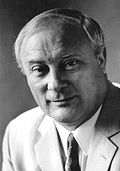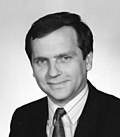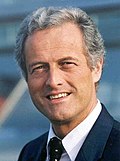List
German Reich (1918–1945)
Political Party: Centre SPD DDP DVP DNVP BVP KVP NSDAP
| No. | Portrait | Name (born–died) | Term of office | Political party | Government | Ref. | |||
|---|---|---|---|---|---|---|---|---|---|
| Took office | Left office | Time in office | |||||||
| Weimar Republic (1918–1933) | |||||||||
| 1 | Johannes Bell (1868–1949) | 13 February 1919 | 1 May 1920 | 1 year, 78 days | Centre | Scheidemann Bauer Müller I | |||
| 2 | Gustav Bauer (1870–1944) | 2 May 1920 | 21 June 1920 | 50 days | SPD | Müller I | |||
| 3 | Wilhelm Groener (1867–1939) | 25 June 1920 | 12 August 1923 | 3 years, 48 days | Independent | Fehrenbach Wirth I–II Cuno | |||
| 4 | Rudolf Oeser (1858–1926) | 12 August 1923 | 11 October 1924 | 1 year, 59 days | DDP | Stresemann I–II [1] Marx I–II | |||
| 5 | Rudolf Krohne (1876–1953) | 12 October 1924 | 17 December 1926 | 2 years, 66 days | DVP | Luther I–II [2] Marx III | |||
| 6 | Wilhelm Koch (1877–1950) | 28 January 1927 | 12 June 1928 | 1 year, 136 days | DNVP | Marx IV | |||
| 7 | Theodor von Guérard (1863–1943) | 27 June 1928 | 6 February 1929 | 224 days | Centre | Müller II | |||
| 8 | Georg Schätzel (1874–1934) | 7 February 1929 | 12 April 1929 | 64 days | BVP | Müller II | |||
| 9 | Adam Stegerwald (1874–1945) | 12 April 1929 | 27 March 1930 | 348 days | Centre | Müller II | |||
| (7) | Theodor von Guérard (1863–1943) | 30 March 1930 | 7 October 1931 | 1 year, 191 days | Centre | Brüning I | |||
| 10 | Gottfried Treviranus (1891–1971) | 9 October 1931 | 30 May 1932 | 234 days | KVP | Brüning II | |||
| 11 | Paul Freiherr von Eltz-Rübenach (1875–1943) | 1 June 1932 | 30 January 1933 | 243 days | Independent | Papen Schleicher | |||
| Nazi Germany (1933–1945) | |||||||||
| (11) | Paul Freiherr von Eltz-Rübenach (1875–1943) | 30 January 1933 | 2 February 1937 | 4 years, 3 days | Independent | Hitler | |||
| 12 |  | Julius Dorpmüller (1869–1945) | 2 February 1937 | 23 May 1945 | 8 years, 110 days | Independent | Hitler von Krosigk | ||
| NSDAP | |||||||||
1 The SPD withdrew from the Stresemann II Cabinet on 3 November 1923.
2 The DNVP withdrew from the Luther I Cabinet on 26 October 1925.
Federal Republic of Germany (1949–present)
Political Party: DP SPD CSU CDU FDP
| No. | Portrait | Name (born–died) | Term of office | Political party | Government | Ref. | |||
|---|---|---|---|---|---|---|---|---|---|
| Took office | Left office | Time in office | |||||||
| Federal Minister for Transport | |||||||||
| 1 |  | Hans-Christoph Seebohm (1903–1967) | 20 September 1949 | 30 November 1966 | DP (1947–1960) | Adenauer (I • II • III • IV • V) Erhard (I • II) | |||
| CDU (1960–1967) | |||||||||
| 2 |  | Georg Leber (1920–2012) | 1 December 1966 | 7 July 1972 | SPD | Kiesinger (I) Brandt (I) | |||
| 3 |  | Lauritz Lauritzen (1910–1980) | 7 July 1972 | 16 May 1974 | SPD | Brandt (I • II) | |||
| 4 |  | Kurt Gscheidle (1924–2003) | 16 May 1974 | 4 November 1980 | SPD | Schmidt (I • II) | |||
| 5 |  | Volker Hauff (born 1940) | 6 November 1980 | 1 October 1982 | SPD | Schmidt (III) | |||
| 6 |  | Werner Dollinger (1918–2008) | 4 October 1982 | 12 March 1987 | CSU | Kohl (I • II) | |||
| 7 |  | Jürgen Warnke (1932–2013) | 12 March 1987 | 21 April 1989 | CSU | Kohl (III) | |||
| 8 |  | Friedrich Zimmermann (1925–2012) | 21 April 1989 | 18 January 1991 | CSU | ||||
| 9 |  | Günther Krause (born 1953) | 18 January 1991 | 13 May 1993 | CDU | Kohl (IV) | |||
| 10 |  | Matthias Wissmann (born 1949) | 13 May 1993 | 26 October 1998 | CDU | Kohl (IV • V) | |||
| Federal Minister for Transport, Building and Housing | |||||||||
| 11 |  | Franz Müntefering (born 1940) | 27 October 1998 | 29 September 1999 | SPD | Schröder (I) | |||
| 12 |  | Reinhard Klimmt (born 1942) | 29 September 1999 | 16 November 2000 | SPD | ||||
| 13 |  | Kurt Bodewig (born 1955) | 20 November 2000 | 22 October 2002 | SPD | ||||
| 14 |  | Manfred Stolpe (1936–2019) | 22 October 2002 | 22 November 2005 | SPD | Schröder (II) | |||
| Federal Minister for Transport, Building and Urban Development | |||||||||
| 15 |  | Wolfgang Tiefensee (born 1955) | 22 November 2005 | 28 October 2009 | SPD | Merkel (I) | |||
| 16 |  | Peter Ramsauer (born 1954) | 28 October 2009 | 17 December 2013 | CSU | Merkel (II) | |||
| Federal Minister for Transport and Digital Infrastructure | |||||||||
| 17 |  | Alexander Dobrindt (born 1970) | 17 December 2013 | 24 October 2017 | CSU | Merkel (III) | |||
| – |  | Christian Schmidt (born 1957) acting | 24 October 2017 | 14 March 2018 | CSU | Merkel (III) | |||
| 18 |  | Andreas Scheuer (born 1974) | 14 March 2018 | 8 December 2021 | CSU | Merkel (IV) | |||
| 19 |  | Volker Wissing (born 1970) | 8 December 2021 | 6 May 2025 | Independent (FDP until November 2024) | Scholz (I) | |||
| Federal Minister for Transport | |||||||||
| 20 |  | Patrick Schnieder (born 1968) | 6 May 2025 | Incumbent | CDU | Merz (I) | |||










